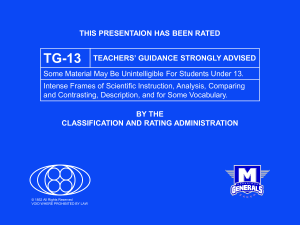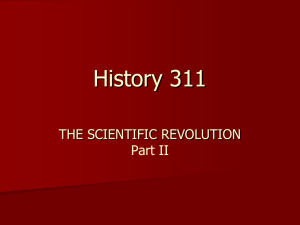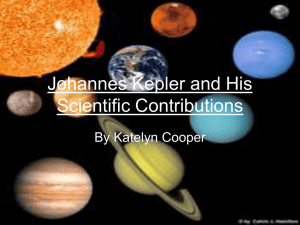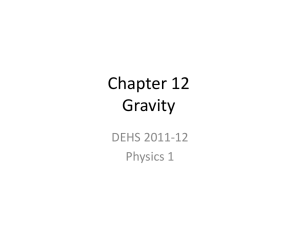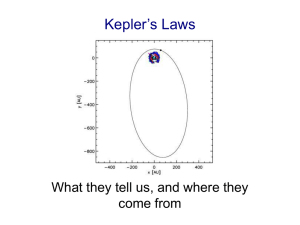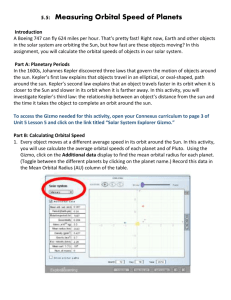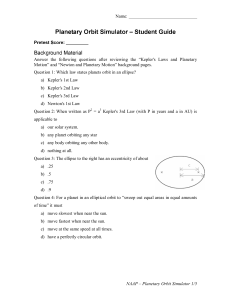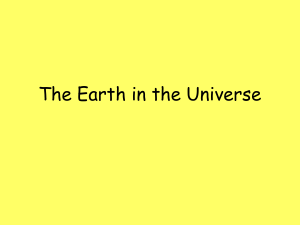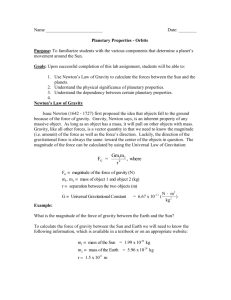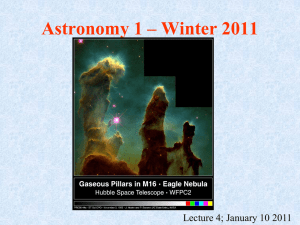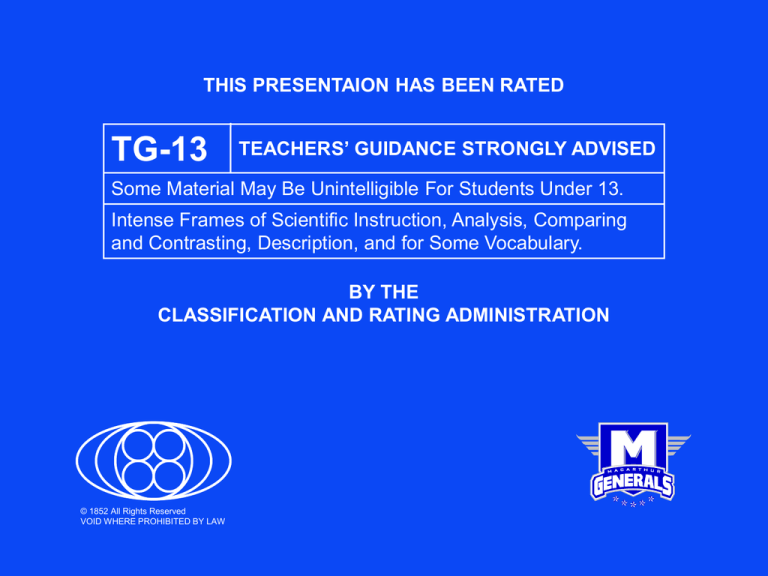
THIS PRESENTAION HAS BEEN RATED
TG-13
TEACHERS’ GUIDANCE STRONGLY ADVISED
Some Material May Be Unintelligible For Students Under 13.
Intense Frames of Scientific Instruction, Analysis, Comparing
and Contrasting, Description, and for Some Vocabulary.
BY THE
CLASSIFICATION AND RATING ADMINISTRATION
© 1852 All Rights Reserved
VOID WHERE PROHIBITED BY LAW
PBIS ANTI-VACUITY
The authorized reproduction or distribution of
this copyrighted work is highly encouraged.
Lethargic obtuseness is insubordinate and is
discouraged by PBIS, as it may result in little
or no monetary gain after secondary
education or a fine of $250,000.
© 1852 All Rights Reserved
VOID WHERE PROHIBITED BY LAW
ASTRONOMY
ORBITAL MECHANICS
OBJECTIVES
By the end of this presentation, students will
be able to
• Describe how the orbits of planets are
defined using Kepler’s laws.
• Evaluate the period of an orbit or the relative
distance of a planet using Kepler’s Law of
Harmony.
KEPLER’S LAWS
OF PLANETARY MOTION
1. Every planet moves around the sun in
an elliptical orbit (near circular, ovals)
with the sun at one focus.
– This describes a simple shape for the
orbit.
– For a more detailed description, the
elements of an orbit need to be
defined.
KEPLER’S LAWS
OF PLANETARY MOTION
• PERIHELION - the point marking the
nearest approach of a planet to the sun.
• APHELION - the point marking the
farthest distance of a planet from the
sun.
KEPLER’S LAWS
OF PLANETARY MOTION
• SEMI-MAJOR AXIS (longest radius) the average distance from the sun.
a = ½(aphelion + perihelion)
• ECENTRICITY - the flatness of the orbit
(how oval or circular).
e = 1- aphelion = perihelion
a
a-1
KEPLER’S LAWS
OF PLANETARY MOTION
The size and shape of the orbit are
described by a and e, whereas the
orbital orientation is described by the
INCLINATION ( i ) - the tilt of the orbital plane
to the orbital plane of the earth.
Planet
Plane of Earth’s
orbit
DESCENDING NODE
r
star PLANET’s ORBIT
ASCENDING NODE
To Vernal Equinox
i
KEPLER’S LAWS
OF PLANETARY MOTION
The distance of the planet from the star
can then be determined by measuring
the angle between the observed
position of the perihelion and the
observed position of the planet (q).
PERIOD (T) - the time for one complete
revolution around the sun.
– Can be used to predict when the
planet will pass any expected point.
KEPLER’S LAWS
OF PLANETARY MOTION
2. A line drawn from the sun to a
planet will sweep out equal
areas of space in equal times.
DQ = constant = pa2
Dt
T
KEPLER’S LAWS
OF PLANETARY MOTION
2. A line drawn from the sun to a
planet will sweep out equal
areas of space in equal times.
- Indicates that the planet
speeds up as it approaches
perihelion and slows down as it
approaches aphelion.
• - Also used to calculate and q.
Planet
r
star
A2
A1
A1 = A2 = p a 2
Dt Dt T
KEPLER’S LAWS
OF PLANETARY MOTION
3. The ratio of the cube of the
average orbital radius to the
square of its period is a
constant.
T2 = K
a3
K = Kepler’s Constant = 4 p2
G mo
KEPLER’S LAWS
OF PLANETARY MOTION
3. The ratio of the cube of the
average orbital radius to the
square of its period is a
constant.
T2 = 4p2 a3
G mo
KEPLER’S LAWS
OF PLANETARY MOTION
3.
T2 = K
a3
Keeping this simple: for objects
orbiting the sun, like the earth,
the earth is 1.0 A.U. from the
sun. It has a period of orbit of
1.0 year.
K = 1.0
According to Bode’s Rule, Saturn
orbits the sun at a relative
distance of 10.0 A.U. What is its
orbital period?
T2 = K a3
T2 = 1.0 (10.0)3
T2 = 1.0 (1000)
T2 = (1000)
T = 31.6 years
How far away from the sun will an
asteroid be if it was to have an
orbital period of 2.0 years?
T2 = K a3
2.02 = 1.0 a3
4.0 = 1.0 a3
4.0 = a3
a = 1.26 A.U.
One of Jupiter’s moons orbits in
1.77 days and is 4.22 units
distance from Jupiter. Another
moon orbits 6.71 units distance.
What is it’s orbital period?
T2 = K a3
(1.77)2 = K (4.22)3
3.1329 = K (75.151)
K = (3.1329)/(75.151)
K = 0.0417
One of Jupiter’s moons orbits in
1.77 days and is 4.22 units
distance from Jupiter. Another
moon orbits 6.71 units distance.
What is it’s orbital period?
T2 = K a3
T2 = (0.0419) (6.71)3
T2 = (0.0419) (302.1)
T2 = (12.66)
T = 3.56 days
A new ‘planet’ has been
discovered at 80.0 A.U. from the
sun. What is its orbital period?
T2 = K a3
T2 = 1.0 (80.0)3
T2 = 1.0 (512,000)
T2 = 512,000
T = 716 years
ASTRONOMY
ORBITAL MECHANICS

